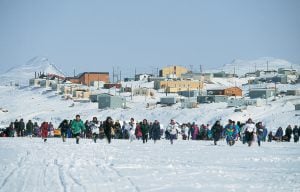The new Mackenzie Valley Highway snakes across the tundra through a landscape dotted with lakes and pingos, ice-cored hills that form in permafrost regions. (Photo: Ray Hyland)
The new road north from Inuvik is a marvel of modern engineering. Stretching 137 kilometres and built at a cost of $300 million, it’s been a long time coming. First proposed in the 1960s, the route was formally surveyed in 1974. The next 40 years were taken up with discussions about funding, environmental impacts and community implications. Construction didn’t commence until 2013, but the decades of assessment have resulted in a road designed to survive the harsh conditions north of the Arctic Circle with minimal impact on the sensitive environment.
Dean Ahmet, Senior Program Manager for the territorial govenment and effectively the man who built the road, explains that its circuitous final path allows for natural drainage of the land with the minimum number of bridges and culverts — no small task in a land of lakes, ice and pingos (ice-cored hills for which the Tuktoyaktuk region is famous). The road itself is elevated and “floats” above the permafrost on a geotextile-fabric bed that prevents road materials from getting into the ground below.
Of course, the greatest impacts of the road will be felt by people in the region. As we proceeded north, we interviewed residents and local business owners to get their perspectives. Depending on who we asked, their feedback was either optimistic, full of longing for increased freedoms and choices, or apprehensive, with concerns around safety and outside influences.
Much of the population of Tuktoyaktuk is excited that they will be able to drive to Inuvik or possibly even Dawson City to stock up on groceries and supplies at a lower cost and in greater variety. As an added bonus, they’ll be able to go whenever they want, unrestricted by barge or aircraft schedules. Many residents are also looking forward to easier access to medical care and government services. Local business owners are hoping for an increase in year-round tourism.






